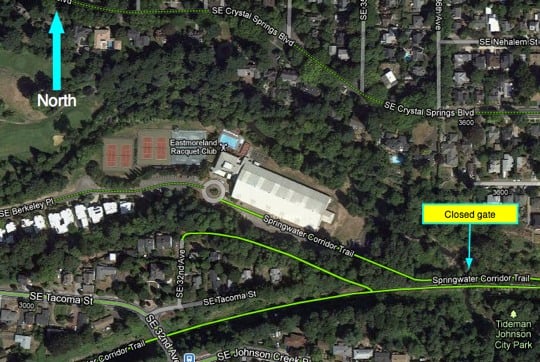
the Springwater Corridor Trail over Johnson Creek.
(Photo: Morrie Erickson)
The owner of the Eastmoreland Racquet Club in southeast Portland has closed a popular section of the Springwater Corridor Trail. As of about one week ago, a gate has been erected across the section of the path that leads through the Racquet Club on the west side of Johnson Creek just west of SE 37th Ave. The closure was done without notifying the City, it has led to confusion for the many bikers and walkers who rely on the route, and local residents have begun a crusade to fight it.
Portland Parks & Recreation spokesman Mark Ross says they have received several inquires about the gate. Asked about it yesterday, Ross told us, “We were not consulted or informed regarding the closure.” He added that the history of this section of the Springwater path is “a bit murky” and that, “We are currently trying to determine ownership before we make any final decisions on what to do with the trail segment.”
The segment in question veers off to the north of the main Springwater Corridor Trail at SE 37th Ave. It provides east-west access on a portion of Parks-owned path, then it transitions onto the Racquet Club’s private property before going back onto public streets at SE Berkeley Place.

Morrie Erickson lives in Racquet Club Estates on SE Berkeley Place, right across the street from the Racquet Club’s tennis courts. He tweeted a photo of the closed gate yesterday. He says the gate was erected by the club’s owner, Terry Emmert of Emmert International.
“Until a week or so ago, runners, walkers, cyclists, and the public generally could pass through the Racquet Club grounds,” Erickson wrote to us via email yesterday. Erickson says he’s dealt with Emmert and this issue before. When he first saw a gate being built a few years ago, he contacted the City of Portland about whether or not the Racquet Club had the right to restrict access. Erickson tracked down City planning documents that clearly state that the property must include a public easement.
“We were not consulted or informed regarding the closure. The history of the section of trail (bridge, path, and gate) is a bit murky.”
— Portland Parks & Recreation spokesman Mark Ross
In 1976, when the Racquet Club was first built, the City of Portland Hearings Officer issued a decision that placed several conditions on the property. One of them read:
“… the applicants shall cooperate with appropriate city departments and other public agencies… to effectuate a pedestrian and bike path from the residential area of primary service to the facility.”
The 1976 decision also established a committee the property owner had to work with to implement the bike path. Members of that committee included members of the City’s Bicycle Pathway Program and the Parks Bureau.
When the Racquet Club’s owners added new buildings to their facility in 1991, local neighborhood associations appealed their land-use permit and the hearings officer added additional conditions: “Prior to issuing building permits for the facilities proposed in this application,” reads the official decision, “the applicant/owner shall dedicate an easement for the 40-Mile Loop Trail…”
Terry Emmert bought the Racquet Club in 1995. According to a 2004 article in the Willamette Week, he was unaware of these easement conditions when he bought the property. That article, as well as one in The Oregonian a few months later detailed Emmert’s intentions to close his property to public access. At that time, Emmert said he wanted to thwart vandalism to club-goers’ cars and prevent people from camping in the wooded area near the creek.

Parks spokesman Mark Ross says Emmert, “Has had a longstanding concern that the path invites users to cross over the bridge and on to their property.” Ross adds that while Parks owns the segment of trail leading up to the Johnson Creek bridge, they might just remove this segment of the path.
“It is our experience that dead-end trails are not useful, and often frustrating to the users. Especially, as is the case in this instance, that it leads users to trespass on private property.”
Ross didn’t give any timeline for public outreach on taking this step, but did say that “We will be working with the community as we move forward making this decision.”
Meanwhile, nearby resident Dagan Wright sees Emmert’s move as, “anti-community and anti-family/pedestrian.” Wright has posted a flyer near the gate that urges the public to speak out about the closure.
Emmert’s office has not returned our calls asking for comment.
As for a detour around the Racquet Club, while east-west Springwater access remains via the three bridges route to the south, Erickson says that route is too far out of the way for many people. “If you live where I do and want to go east, you can’t get to the Springwater. Nor can others who live in Sellwood north of Tacoma — they would have to cycle several blocks south to catch the three bridges route… if you live in Eastmoreland and you’re traveling to Sellwood or Westmoreland park, it’s much faster and more convenient to pass through the Racquet Club.”
“Unless the planning conditions for the club have changed since 1991,” he says, “it seems those conditions should be enforced.”

